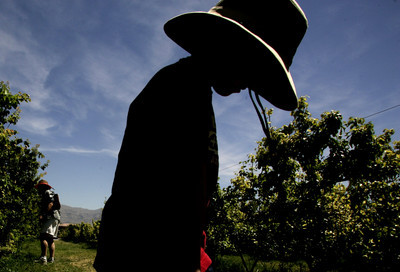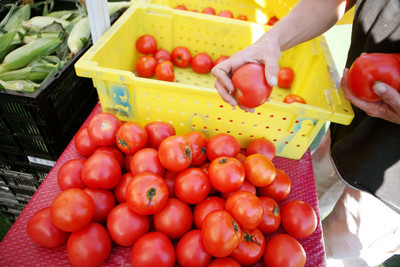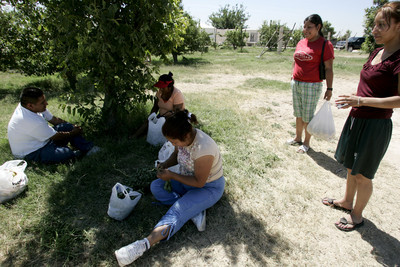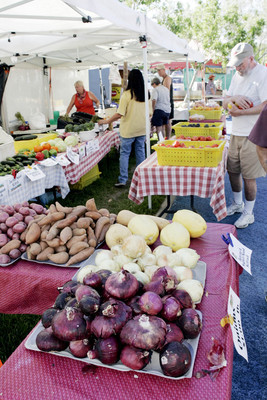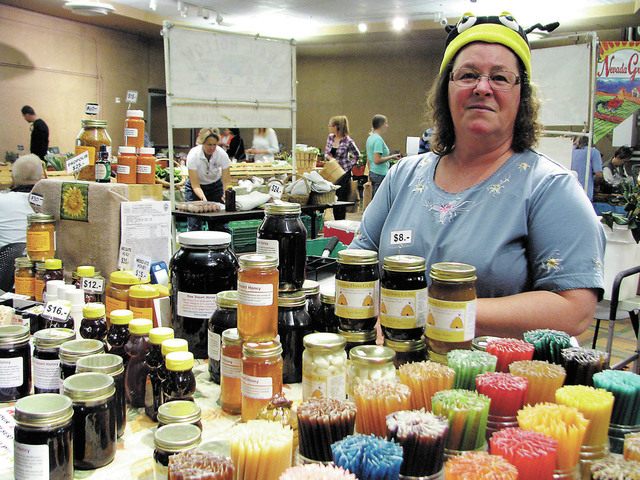PICK OF THE PRODUCE
Sharon Williams and Tammy Edwards waited in a line of traffic on a recent Saturday morning to get into Gilcrease Orchard in North Las Vegas. They paid $2 each for the privilege of engaging in a little manual labor, then waited in a much longer, much slower line of vehicles to pay again -- this time for the apricots and zucchini they'd picked -- and make their way out of the orchard.
Why, in an era when we're all so time-pressed, would they do that?
"The selection, prices," Edwards said. "It's much fresher than in the stores."
Plus, Williams said, "it's so peaceful" within the orchard grounds.
Youthful, concerned about the quality of their food and clearly up for a little adventure, Williams and Edwards appeared to be typical of what spokesman Mark Fierro said is the average orchard customer.
"Yoga moms," Fierro said. "You see a lot of women who are very, very knowledgeable about nutrition, who really want fresh. They understand that fresh doesn't just mean not green and not old," but also not processed, and grown with as few pesticides as possible.
In our desert environment it may seem like the only choice for fruits and vegetables is the supermarket produce section -- or, for the truly ambitious, growing your own -- but more and more Las Vegans are realizing that they have a fresh alternative: Gilcrease Orchard in North Las Vegas and the various farmers' markets that dot the valley.
With the exception of Gilcrease, the supply doesn't really fit the definition of eating locally -- since the nearest agricultural areas are several hundred miles away -- but compared to getting the produce from, say, South America, it's the next best thing.
"People are willing to give it a try," said Donna Eady of Highland Harvest Barn in Highland, Calif., which is west of San Bernardino, as she sold produce on a recent Thursday afternoon at the farmers' market at the Henderson Events Plaza.
Among them are Steve Roth and Jennifer Baade, who recently made their first visit to the market at the Springs Preserve. They frequently go to the market at Gardens Park, they said, and patronized Southern California farmers' markets when they lived there.
"It's good to back local growers," Baade said.
"It's fresh and organic," Roth added. "You've got to support them to see them really grow."
Baade said she thought the prices compared favorably to those in local supermarkets, but Eady said price doesn't seem to be a big motivator for her customers.
"I don't think we're cheaper than the stores," she said. But, she's confident her produce is fresher.
Priscilla Van Dyke of Joe Van Dyke Farms in Blythe, Calif., which is almost due north of Yuma, Ariz., agreed.
"People come and want us to be the same price as 99 Cents Only stores," she said on a recent Thursday at the market at North Las Vegas City Hall. "We may be more expensive, but I know it was picked on Monday, and I know what went onto it." (Van Dyke also has a stand at Springs Preserve later on Thursdays, and at Bruce Trent Park on Wednesdays.)
And sometimes knowing "what went onto it" is enough. Van Dyke noted last week that her tomatoes are California home-grown, and "salmonella-free."
At any time, Eady said, tomatoes are a big draw, because supermarket tomatoes are notoriously weak on flavor.
Eady and her husband have had their stand at the Henderson market for 10 years, she said, and she notices a big increase this year as awareness grows.
But those frequenting farmers' markets shouldn't expect the vast variety they find in supermarkets, mainly because most of the latter deal in produce from all over, so the supply isn't as dependent on seasonality and other aspects of availability.
A couple of weeks ago, Van Dyke was the only produce vendor at the North Las Vegas market, and Eady the only one at the Henderson market. At Springs Preserve, there was one other large produce vendor besides Van Dyke, plus somebody selling strawberries. The rest of the booths are taken by those selling plants, food such as kettle corn, and craft and specialty items.
And the produce vendors that are in the markets have, by their very nature, a fluctuating supply.
"We're very seasonal with our produce," said Van Dyke, noting that the couple start in late October or early November with a few fall melons and fall corn and go until about Christmas, when they take about a month and a half off. Then they're back with "all kinds of greens -- lettuce, spinach, mustard, turnip" -- and continue with "lots of short-term crops in between" until July, when it gets too hot.
Eady said she and her husband take a couple of weeks off in December but otherwise go year-round -- even in the dead of summer, though they're likely in those months to close up earlier in the afternoon.
At Gilcrease -- which is run by a nonprofit foundation -- the season started June 3 with apricots, zucchini and pecans. Tomatoes, cantaloupe and figs are expected to be ready from about the end of this month through November; peaches and pomegranates in July through September; watermelon and apples in July through November; butternut and acorn squash in summer and fall; pears in August through December; pumpkins in September and October; and yellow, red and green peppers in August through November. Sun-dried tomatoes are expected to be available at the end of the summer, and fresh-made apple cider from the orchard's trees is sold all year.
Van Dyke said small growers get a bit of a boost from the Senior Farmers' Market Nutrition Program, for which the state of Nevada gets funding from the USDA Food and Nutrition Program to distribute coupon books -- to be used at farmers' markets -- to seniors who meet income ceilings. She also lauded city and county organizers who have helped increase awareness of the markets through publicity.
But both she and Eady said they're being increasingly affected by skyrocketing fuel prices. Van Dyke noted that not long ago, it cost $120 to fill their truck, and recently that had risen to $330. Eady said she and her husband had switched to a smaller vehicle to try to save fuel.
Still, she said, it will be "interesting when we see what the impact of gasoline has."
Contact reporter Heidi Knapp Rinella at hrinella@reviewjournal.com or 702-383-0474.
PRODUCE SHOPPING Here's where to find local farmers' markets and Gilcrease Orchard. (Admission to the markets is free; the orchard charges $2 per person for adults, $1 for children, with only cash accepted.) Bruce Trent Park, 1600 N. Rampart Blvd., 4 to 8 p.m. Wednesday Gardens Park, 10401 Garden Park Drive, 4 to 8 p.m. Tuesday Gilcrease Orchard, 7810 N. Tenaya Way, 7 a.m. to noon Tuesday through Sunday (645-1126 orwww.gilcreaseorchard.org) Henderson Events Plaza, 200 Water St., Henderson, 11 a.m. to 6 p.m. Thursday Nature Discovery Park, 2627 Nature Park Drive, North Las Vegas, 2 to 7 p.m. Friday North Las Vegas City Hall, 2200 Civic Center Drive, North Las Vegas, 10 a.m. to 2 p.m. Thursday Springs Preserve, 333 S. Valley View Blvd., 4 to 8 p.m. Thursday. By HEIDI KNAPP RINELLA




